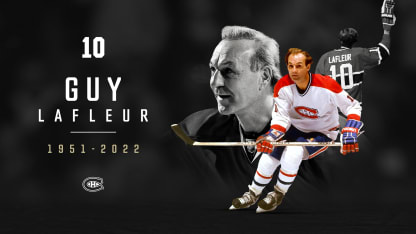Guy Lafleur passes away at the age of 70
Details regarding the upcoming schedule to honor Guy and celebrate his life will be announced soon

"We are deeply saddened to learn of the death of Guy Lafleur. All members of the Canadiens organization are devastated by his passing. Guy had an exceptional career and always remained humble, accessible and close to the Habs and hockey fans in Quebec, Canada and around the world. Throughout his career, he allowed us to experience great moments of collective pride. He was one of the greatest players in our organization while becoming an extraordinary ambassador for our organization and for hockey," said Geoff Molson, owner, President and CEO of the Montreal Canadiens.
"Guy is part of the Canadiens family and the organization will provide all the necessary support to the members of his family and his close circle of friends during this extremely difficult time. On behalf of the Molson family and all members of the Montreal Canadiens organization, I extend my deepest sympathies to his wife Lise and his sons Martin and Mark," said Mr. Molson.
Further details regarding the schedule of upcoming events to celebrate and honor his life and Hall-of-Fame career will be announced shortly.
Born September 20, 1951 in Thurso, Quebec, Guy Damien Lafleur would become one of the greatest legends in Montreal Canadiens and NHL history, standing alongside Maurice Richard and Jean Beliveau as the biggest stars to play for the game's most legendary franchise.
The top junior player in the country, Lafleur finished his amateur career as the most coveted prospect in hockey. His Quebec Remparts won the 1971 Memorial Cup, with Lafleur recording an incredible 130 goals and 209 points in his last amateur season.
Just as Frank Selke had done 20 years earlier with Beliveau, Canadiens General Manager Sam Pollockwent to great lengths to ensure the premiere talent in the Draft landed in Montreal, trading several skilled players to ensure Lafleur would enter the NHL wearing the bleu-blanc-rouge as the first-overall pick.
Lafleur scored 29 goals in his rookie year of 1971-72, 28 the next - the same year his name was added to the Stanley Cup for the first time - and 21 in his third season. "The Flower," as he was known to teammates, blossomed in 1974-75, more than doubling the previous season's numbers with 53 goals and 66 assists. Now referred to as "Le Démon Blond," in some quarters, Lafleur had emerged as the single most exciting player in the league.
As the Montreal Canadiens enjoyed success unseen since the 1950s, winning four consecutive titles from 1976 through the end of the decade, Lafleur led the way, with both his scoring numbers and his strength of character. Nothing came before the game, as Lafleur dedicated himself to a single objective: having his team come out on top every night.
Dressed and ready to go hours before the puck dropped, the sight of Lafleur in full flight, the puck on his stick and shaggy locks flying in his jet stream as he led a dazzling rush, made highlight packages around North America. Televisions were flooded with images of him being mobbed by teammates, celebrating yet another goal as he reeled off six consecutive seasons that saw him break the 50-goal barrier, with a career high of 60 in 1977-78.
Lafleur accumulated an impressive array of individual awards to accompany his five Stanley Cup Championships. In 1976, he began a three-year domination of both the Art Ross Trophy, given to the NHL's top scorer, and the Pearson Trophy, awarded to the league's top performer by his playing peers.
The spring of 1977 saw Lafleur win the first of two consecutive Hart Trophies, awarded to the NHL's most valuable player. His 26 playoff points earned Lafleur the Conn Smythe Trophy as the postseason MVP and paved the way to that year's Stanley Cup parade.
Shortly after the 1984-85 season got underway, Lafleur shocked the hockey world with the news that he had decided to retire. He left the game with 518 regular season goals, a total second only to Maurice Richard's 544. His 728 assists and 1,246 points in regular season competition lead all Habs to this day.
Inducted to the Hockey Hall of Fame in 1988 after his No. 10 was retired by the Canadiens on February 16, 1985, Lafleur returned the next season. He suited up with the Rangers and Nordiques until 1990-91, becoming the second player after Gordie Howe to play in the NHL after being enshrined in the Hall of Fame.
Named a Montreal Canadiens Ambassador after he left the game for good, Lafleur was a regular presence at team events both around games and in the community for parts of four separate decades following his retirement. He leaves behind an incredible legacy that will be remembered for generations, his statue outside the Bell Centre testament to the enduring impact he made on a team, a province, and an entire sport.


















